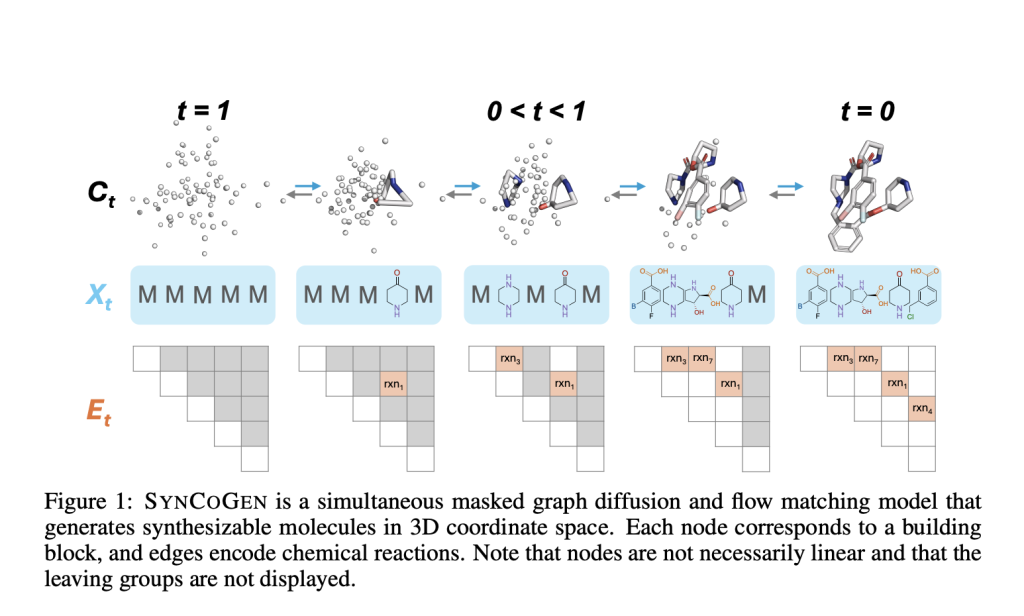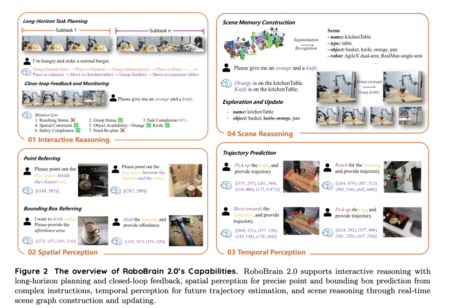Introduction: The Challenge of Synthesizable Molecule Generation
In modern drug discovery, generative molecular design models have greatly expanded the chemical space available to researchers, enabling rapid exploration of new compounds. Yet, a major challenge remains: many AI-generated molecules are difficult or impossible to synthesize in the laboratory, limiting their practical value in pharmaceutical and chemical development.
While template-based methods—such as synthesis trees constructed from reaction templates—help address synthetic accessibility, these approaches only capture 2D molecular graphs, lacking the rich 3D structural information that determines a molecule’s behaviour in biological systems.
Bridging 3D Structure and Synthesis: The Need for a Unified Framework
Recent advances in 3D generative models can directly generate atomic coordinates, allowing for geometry-based design and improved property prediction. However, most methods do not systematically integrate synthetic feasibility constraints: the resulting molecules may possess desired shapes or properties, but there is no guarantee they can be assembled from existing building blocks using known reactions.
Synthetic accessibility is crucial for successful drug discovery and materials design, prompting the need for solutions that simultaneously ensure both realistic 3D geometry and direct synthetic routes.

SYNCOGEN: A Novel Framework for Synthesizable 3D Molecule Design
Researchers from the University of Toronto, University of Cambridge, McGill University, and others have proposed SYNCOGEN (Synthesizable Co-Generation) that addresses this gap with a pioneering approach that jointly models both reaction pathways and atomic coordinates during molecule generation. This unified framework enables the generation of 3D molecular structures along with tractable synthetic routes, ensuring that every proposed molecule is not only physically meaningful but also practically synthesizable.
Key Innovations of SYNCOGEN
- Multimodal Generation: By blending masked graph diffusion (for reaction graphs) with flow matching (for atomic coordinates), SYNCOGEN samples from the joint distribution of building blocks, chemical reactions, and 3D structures.
- Comprehensive Input Representation: Each molecule is represented as a triple (X, E, C), where:
- X encodes building block identity,
- E encodes reaction types and specific connection centers,
- C contains all atomic coordinates.
- Simultaneous Training: Both graph and coordinate modalities are modeled together, using losses that combine cross-entropy for graphs, masked mean squared error for coordinates, and pairwise distance penalties to ensure geometric realism.

The SYNSPACE Dataset: Enabling Large-Scale, Synthesizability-Aware Training
To train SYNCOGEN, researchers created SYNSPACE, a dataset featuring over 600,000 synthesizable molecules, each constructed from 93 commercial building blocks and 19 robust reaction templates. Every molecule in SYNSPACE is annotated with multiple energy-minimized 3D conformations (over 3.3 million structures total), providing a diverse and reliable training resource that closely mirrors realistic chemical synthesis.
Dataset Construction Workflow
- Molecules are systematically built by iterative reaction assembly, starting from an initial building block and choosing compatible reaction centers and partners for successive coupling steps.
- For each resulting molecular graph, multiple low-energy conformers are generated and optimized using computational chemistry methods, ensuring each structure is both chemically plausible and energetically favourable.
Model Architecture and Training
SYNCOGEN leverages a modified SEMLAFLOW backbone, an SE(3)-equivariant neural network originally designed for 3D molecular generation. The architecture includes:
- Specialized input and output heads to translate between building block-level graphs and atom-level features.
- Loss functions and noising schemes that carefully balance graph accuracy and 3D structural fidelity, including visibility-aware coordinate handling to support variable atom counts and masking.
- Training innovations such as edge count limits, compatibility masking, and self-conditioning to maintain chemistry-valid molecule generation.
Performance: State-of-the-Art Results in Synthesizable Molecule Generation
Benchmarking
SYNCOGEN achieves state-of-the-art performance on unconditional 3D molecule generation tasks, outperforming leading all-atom and graph-based generative frameworks. Notable improvements include:
- High chemical validity: More than 96% of generated molecules are chemically valid.
- Superior synthetic accessibility: Retrosynthesis software (AiZynthFinder, Syntheseus) solve rates of up to 72%, far surpassing most competing methods.
- Excellent geometric and energetic realism: Generated conformers closely match the bond length, angle, and dihedral distributions of experimental datasets, with low non-bonded interaction energies.
- Practical utility: SYNCOGEN enables direct generation of synthetic routes alongside 3D coordinates, uniquely bridging computational chemistry and experimental synthesis.
Fragment Linking and Drug Design
SYNCOGEN also demonstrates competitive performance in molecular inpainting for fragment linking, a crucial drug design task. It can generate easily synthesizable analogs of complex drugs, producing candidates with favorable docking scores and retrosynthetic tractability—a feat not matched by conventional 3D generative models.
Future Directions and Applications
SYNCOGEN marks a foundational advance for synthesizability-aware molecular generation, with potential extensions including:
- Property-conditioned generation: Directly optimize for desired physicochemical or biological properties.
- Protein pocket conditioning: Generate ligands customized for specific protein binding sites.
- Expanding reaction space: Incorporate more diverse building blocks and reaction templates to widen accessible chemical space.
- Automated synthesis robotics: Link generative models with laboratory automation for closed-loop drug and materials discovery.
Conclusion: A Step Toward Realizable Computational Molecular Design
SYNCOGEN sets a new benchmark for joint 3D and reaction-aware molecule generation, enabling researchers and pharmaceutical scientists to design molecules that are both structurally meaningful and experimentally feasible. By uniting generative models with strict synthetic constraints, SYNCOGEN brings computational design much closer to laboratory realization, unlocking new opportunities in drug discovery, materials science, and beyond.
FAQ 1: What is SYNCOGEN and how does it improve synthesizable 3D molecule generation?
SYNCOGEN is an advanced generative modeling framework that simultaneously generates both the 3D structures and the synthetic reaction pathways for small molecules. By jointly modeling reaction graphs and atomic coordinates, SYNCOGEN ensures that generated molecules are not only physically realistic but also easily synthesizable in real-world laboratory settings. This dual approach uniquely enables practical molecule design for drug discovery, bridging a critical gap left by earlier models that focused only on 2D structures or neglect synthetic accessibility.
FAQ 2: How is SYNCOGEN trained to guarantee synthetic accessibility and 3D accuracy?
SYNCOGEN is trained using the SYNSPACE dataset, which includes over 600,000 synthesizable molecules constructed from a fixed set of reliable building blocks and reaction templates, each paired with multiple energy-minimized 3D conformers. The model utilizes masked graph diffusion for the reaction graph and flow matching for atomic coordinates, combining graph cross-entropy, coordinate mean squared error, and pairwise distance penalties during training to enforce both chemical validity and geometric realism. Training-time constraints, such as edge count limits and compatibility masking, further ensure the generation of practical, chemistry-valid molecules.
FAQ 3: What are the main applications and future directions for SYNCOGEN in chemical and pharmaceutical research?
SYNCOGEN sets a new standard for synthesizability-aware 3D molecule generation, enabling direct suggestion of synthetic routes alongside 3D structures—key for drug design, fragment linking, and automated synthesis platforms. Future applications include conditioning generation on specific properties or protein binding pockets, expanding the library of applicable reactions and building blocks, and integrating with laboratory robotics for fully automated molecule synthesis and screening.
Check out the Paper here. All credit for this research goes to the researchers of this project.
Meet the AI Dev Newsletter read by 40k+ Devs and Researchers from NVIDIA, OpenAI, DeepMind, Meta, Microsoft, JP Morgan Chase, Amgen, Aflac, Wells Fargo and 100s more [SUBSCRIBE NOW]
The post SYNCOGEN: A Machine Learning Framework for Synthesizable 3D Molecular Generation Through Joint Graph and Coordinate Modeling appeared first on MarkTechPost.
Source: Read MoreÂ




